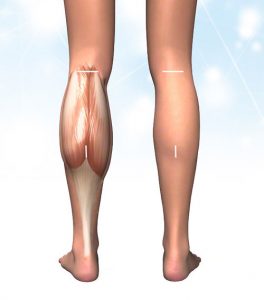Calf reduction by nerve transection (denervation) means cutting the nerve trunks supplying the gastrocnemius muscle.
After the nerve has been severed, the muscle atrophies, leading to a reduction in circumference. However, this cannot be compared with the effect of gastrocnemius removal.
Comparison with standard calf reduction
With nerve transection, circumference reductions of usually 2 to 4 cm are achieved (depending on the circumference of the calf). However, with a calf circumference of 43 cm, we have already achieved a reduction of 6 cm with denervation.
Furthermore, the calf muscle can also be supplied by individual nerve branches that do not originate from the typical bundles in the hollow of the knee. These branches can partially replace the lost nerve trunks and thus prevent the desired muscle shrinkage.
Selective approach
In the so-called selective neurectomy (denervation) for calf reduction, not only the nerve branch of the inner head of the gastrocnemius is severed. The branch of the lateral muscle head is also blocked despite its immediate proximity to the nerve branch of the soleus muscle.
We consider this to be important, as the external gastrocnemius muscle can otherwise grow compensatory.
Advantages
- If the nerves run normally, the procedure is less complex.
- A short recovery period can be expected.
- Reduced risk of complications due to very small wound areas, especially in comparison to muscle removal and liposuction.
- The scars are usually almost invisible.
- Compared to calf reduction without surgery by injection with Btx, the effect is permanent.
Disadvantages
- Due to atypical nerve courses, the procedure is reserved for very experienced plastic surgeons.
- Calf reduction is only possible to a lesser extent.
- A completely healthy muscle is denervated.


